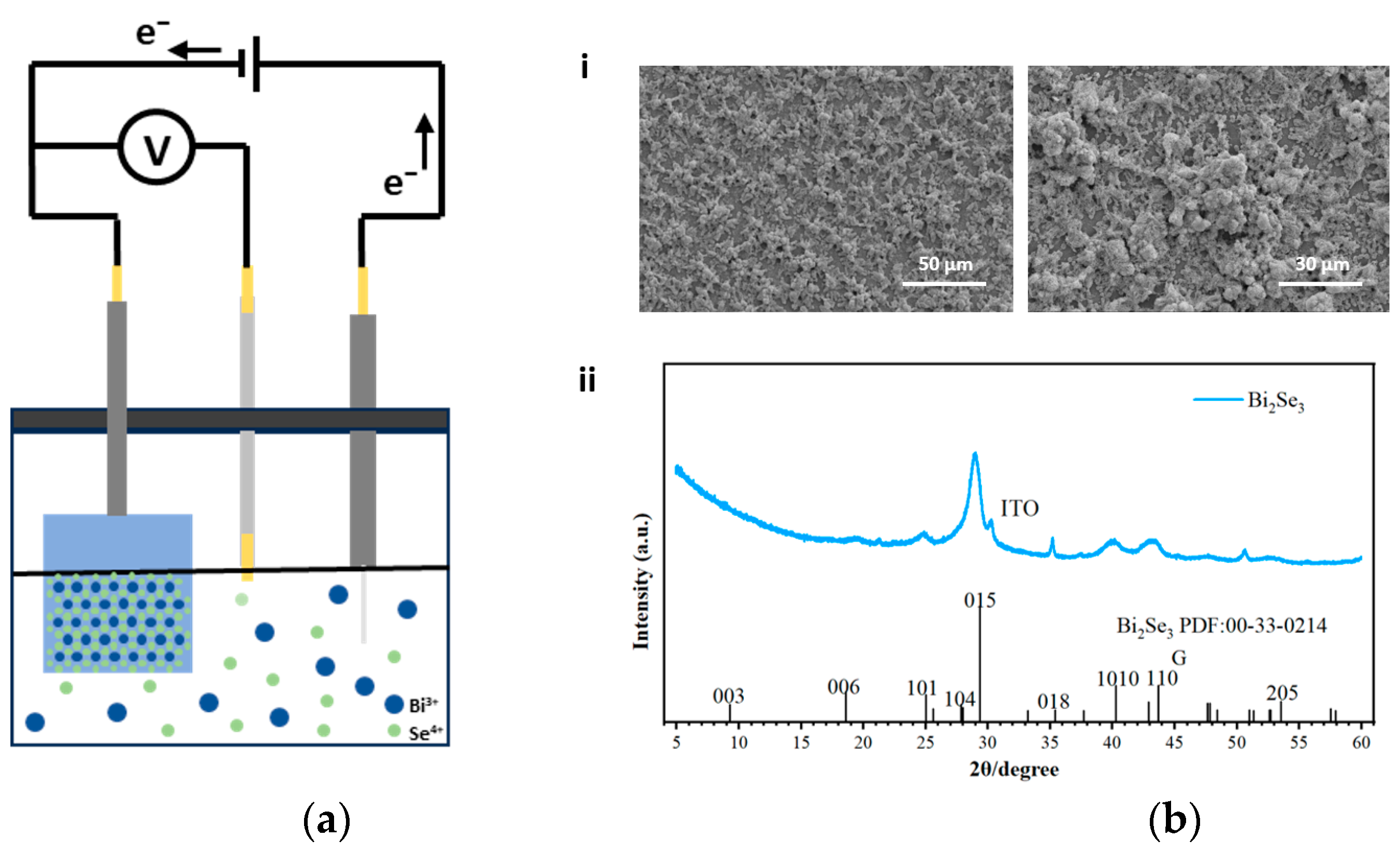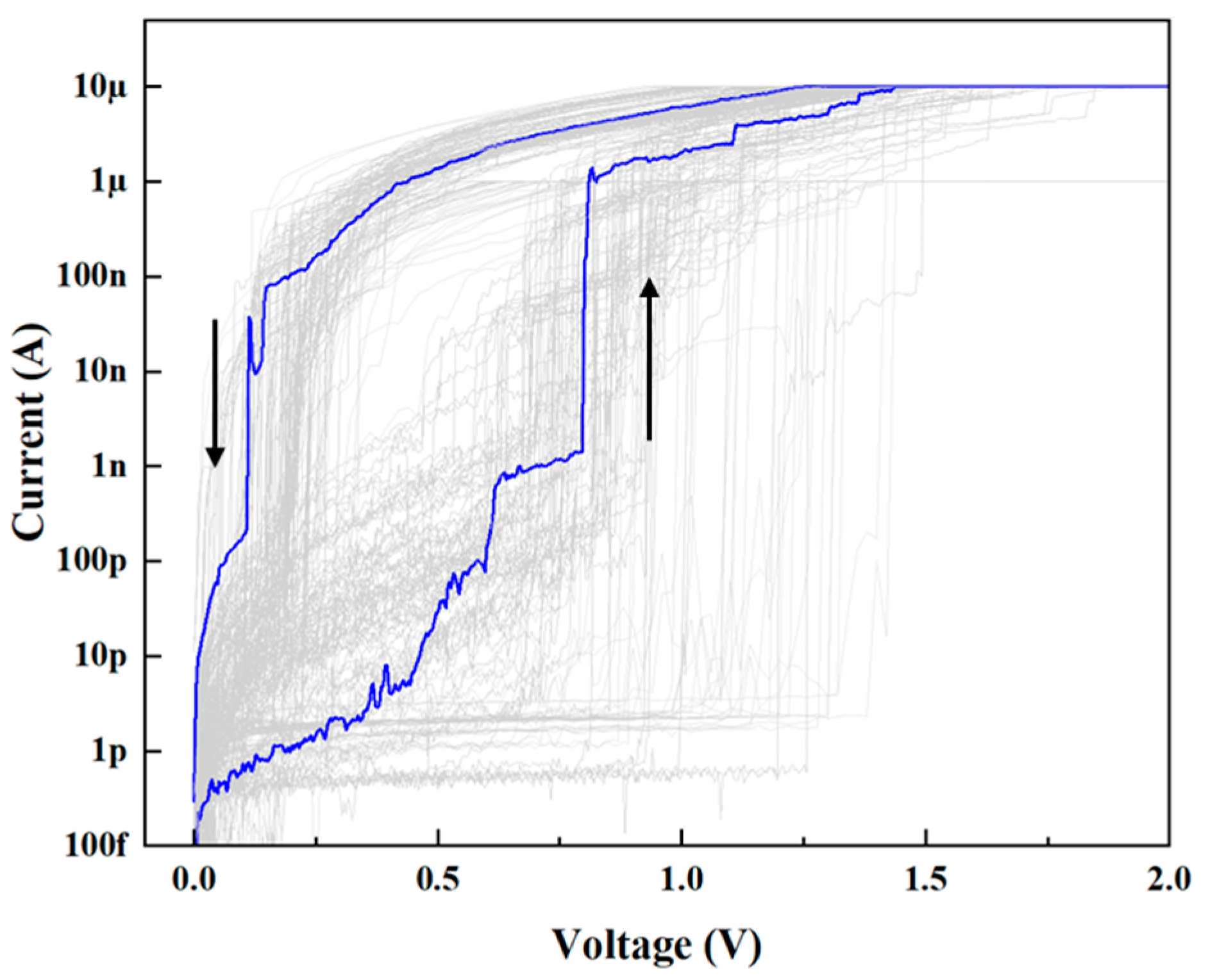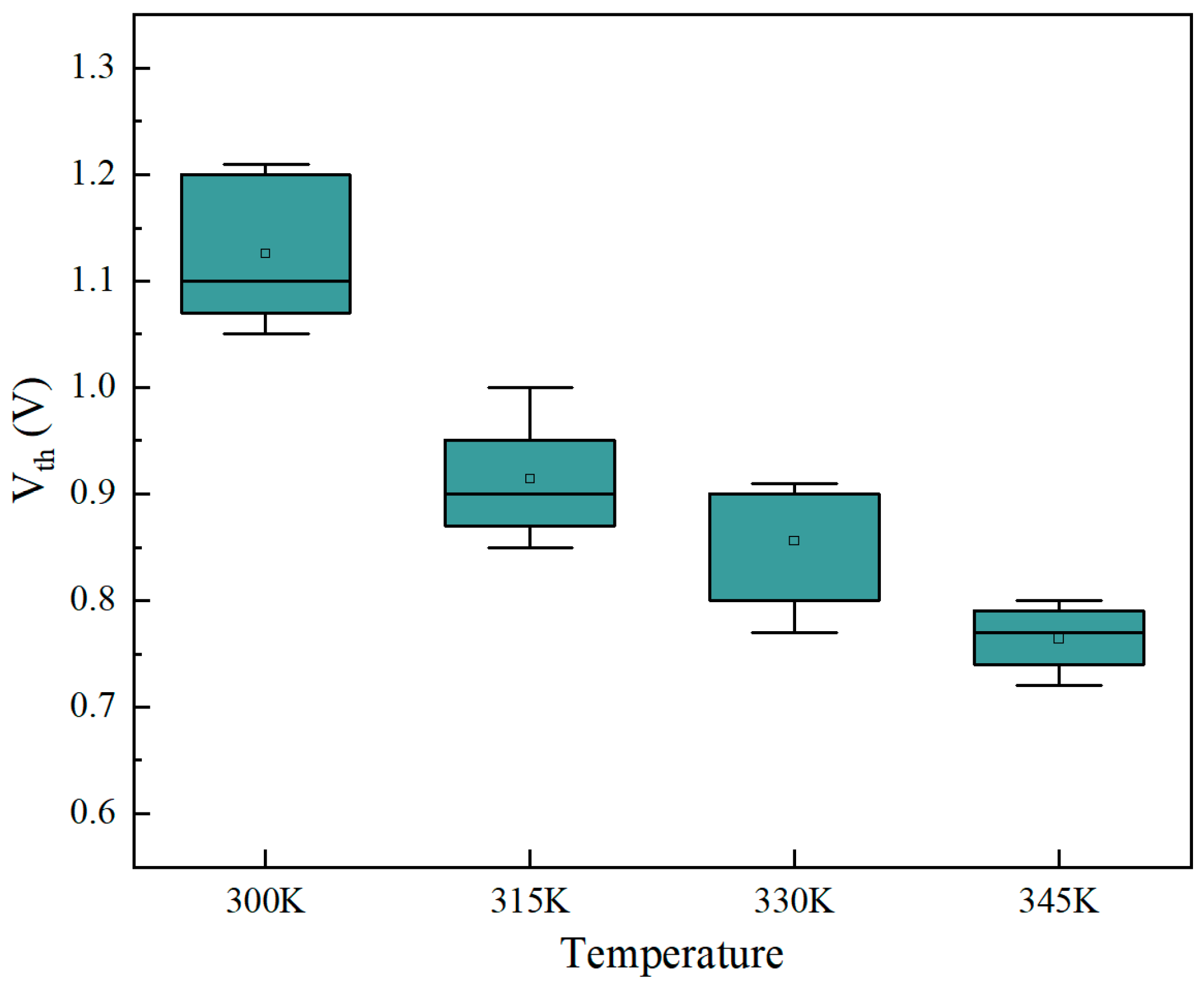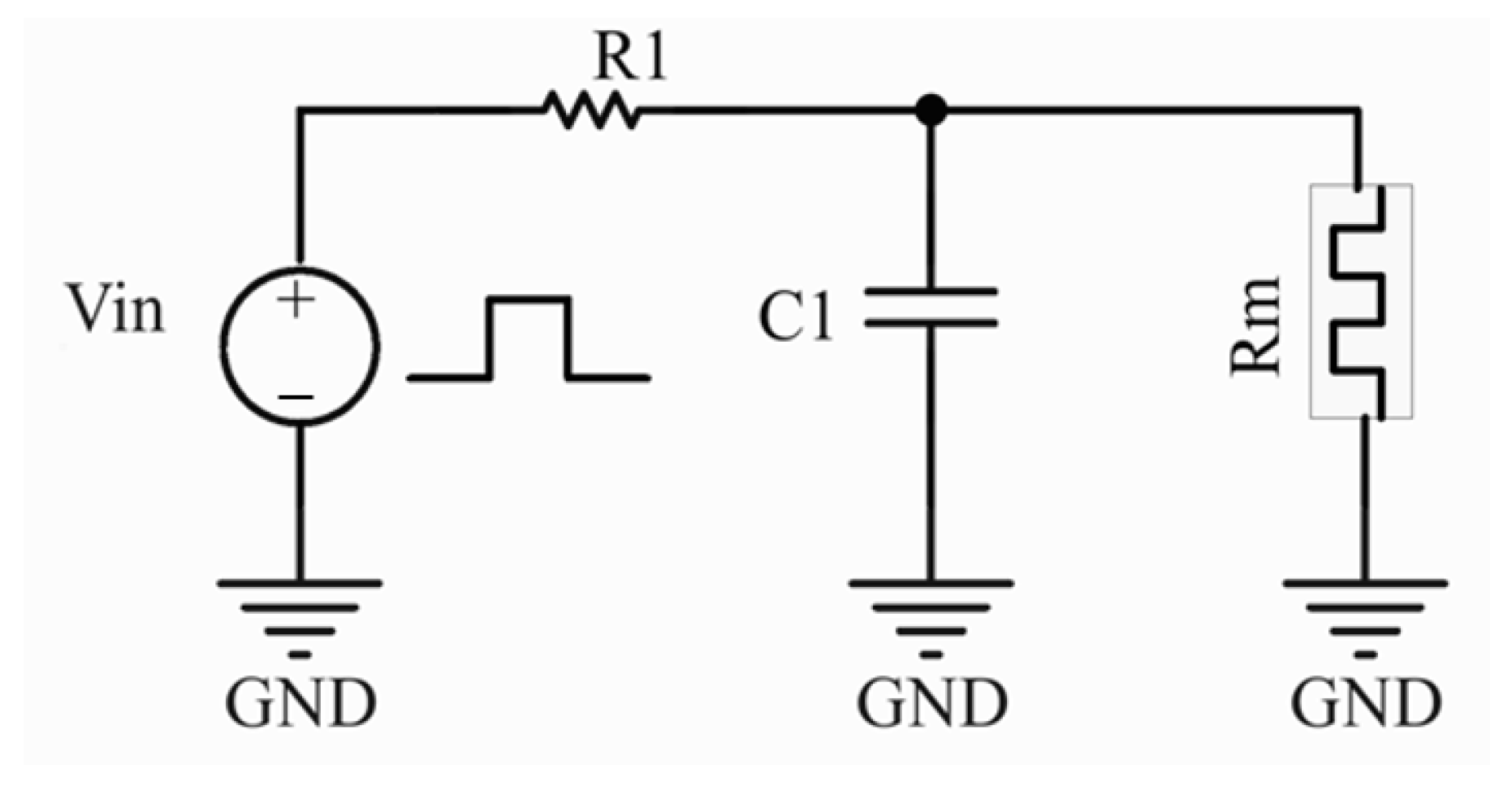Threshold-Switching Memristors for Neuromorphic Thermoreception
Abstract
1. Introduction
2. Material and Methods
3. Results
3.1. Device Performance
3.2. Neuronal Circuit Simulation
4. Conclusions
Author Contributions
Funding
Institutional Review Board Statement
Informed Consent Statement
Data Availability Statement
Acknowledgments
Conflicts of Interest
Abbreviations
| CMOS | Complementary Metal–Oxide Semiconductor |
| TS | Threshold Switching |
| PMMA | Poly Methyl Meth-Acrylate |
| DMF | Dimethylformamide |
| BE | Bottom Electrode |
| TE | Top Electrode |
| SEM | Scanning Electron Microscopy |
| XRD | X-Ray Diffraction |
| ITO | Indium Tin Oxide |
| LRS | Low Resistance State |
| HRS | High Resistance State |
| RC | Resistor Capacitance |
References
- Duan, X.; Cao, Z.; Gao, K.; Yan, W.; Sun, S.; Zhou, G.; Wu, Z.; Ren, F.; Sun, B. Memristor-Based Neuromorphic Chips. Adv. Mater. 2024, 36, 2310704. [Google Scholar] [CrossRef] [PubMed]
- Zhang, W.; Yao, P.; Gao, B.; Liu, Q.; Wu, D.; Zhang, Q.; Li, Y.; Qin, Q.; Li, J.; Zhu, Z.; et al. Edge learning using a fully integrated neuro-inspired memristor chip. Science 2023, 381, 1205–1211. [Google Scholar] [CrossRef] [PubMed]
- Hua, Q.; Gao, G.; Jiang, C.; Yu, J.; Sun, J.; Zhang, T.; Gao, B.; Cheng, W.; Liang, R.; Qian, H.; et al. Atomic Threshold-Switching Enabled MoS2 Transistors towards Ultralow-Power Electronics. Nat. Commun. 2020, 11, 6207. [Google Scholar] [CrossRef]
- Xu, H.; Shang, D.; Luo, Q.; An, J.; Li, Y.; Wu, S.; Yao, Z.; Zhang, W.; Xu, X.; Dou, C.; et al. A low-power vertical dual-gate neurotransistor with short-term memory for high energy-efficient neuromorphic computing. Nat. Commun. 2023, 14, 6385. [Google Scholar] [CrossRef] [PubMed]
- Yi, W.; Tsang, K.K.; Lam, S.K.; Bai, X.; Crowell, J.A.; Flores, E.A. Biological plausibility and stochasticity in scalable VO2 active memristor neurons. Nat. Commun. 2018, 9, 4661. [Google Scholar] [CrossRef]
- Baek, E.; Song, S.; Baek, C.-K.; Rong, Z.; Shi, L.; Cannistraci, C.V. Neuromorphic dendritic network computation with silent synapses for visual motion perception. Nat. Electron. 2024, 7, 454–465. [Google Scholar] [CrossRef]
- Bonagiri, A.; Das, S.K.; Marquez, C.V.; Rúa, A.; Puyoo, E.; Nath, S.K.; Albertini, D.; Baboux, N.; Uenuma, M.; Elliman, R.G.; et al. Biorealistic Neuronal Temperature-Sensitive Dynamics within Threshold Switching Memristors: Toward Neuromorphic Thermosensation. ACS Appl. Mater. Interfaces 2024, 16, 31283–31293. [Google Scholar] [CrossRef]
- Rahman, M.A.; Walia, S.; Naznee, S.; Taha, M.; Nirantar, S.; Rahman, F.; Bhaskaran, M.; Sriram, S. Artificial Somatosensors: Feedback Receptors for Electronic Skins. Adv. Intell. Syst. 2020, 2, 2000094. [Google Scholar] [CrossRef]
- Duan, Q.; Zhang, T.; Liu, C.; Yuan, R.; Li, G.; Tiw, P.J.; Yang, K.; Ge, C.; Yang, Y.; Huang, R. Artificial Multisensory Neurons with Fused Haptic and Temperature Perception for Multimodal In-Sensor Computing. Adv. Intell. Syst. 2022, 4, 2200039. [Google Scholar] [CrossRef]
- Zhu, J.; Zhang, X.; Wang, R.; Wang, M.; Chen, P.; Cheng, L.; Wu, Z.; Wang, Y.; Liu, Q.; Liu, M. A Heterogeneously Integrated Spiking Neuron Array for Multimode-Fused Perception and Object Classification. Adv. Mater. 2022, 34, 2200481. [Google Scholar] [CrossRef]
- Wang, B.; Shi, Y.; Li, H.; Hua, Q.; Ji, K.; Dong, Z.; Cui, Z.; Huang, T.; Chen, Z.; Wei, R.; et al. Body-Integrated Ultrasensitive All-Textile Pressure Sensors for Skin-Inspired Artificial Sensory Systems. Small Sci. 2024, 4, 2400026. [Google Scholar] [CrossRef]
- Zhang, S.; Ma, B.; Zhou, X.; Hua, Q.; Gong, J.; Liu, T.; Cui, X.; Zhu, J.; Guo, W.; Jing, L.; et al. Strain-controlled Power Devices as Inspired by Human Reflex. Nat. Commun. 2020, 11, 326. [Google Scholar] [CrossRef] [PubMed]
- Yoon, J.H.; Wang, Z.; Kim, K.M.; Wu, H.; Ravichandran, V.; Xia, Q.; Hwang, C.S.; Yang, J.J. An artificial nociceptor based on a diffusive memristor. Nat. Commun. 2018, 9, 417. [Google Scholar] [CrossRef]
- Yadlapalli, S.; Jiang, C.; Bahle, A.; Reddy, P.; Meyhofer, E.; Shafer, O.T. Circadian clock neurons constantly monitor environmental temperature to set sleep timing. Nature 2018, 555, 98–102. [Google Scholar] [CrossRef]
- Rouyer, F.; Chatterjee, A. A receptor for subtle temperature changes. Nature 2015, 527, 449–451. [Google Scholar] [CrossRef]
- Bian, H.; Goh, Y.Y.; Liu, Y.; Ling, H.; Xie, L.; Liu, X. Power-efficient neural network with artificial dendrites. Nat. Nanotechnol. 2020, 15, 776–782. [Google Scholar]
- Bian, H.; Goh, Y.Y.; Liu, Y.; Ling, H.; Xie, L.; Liu, X. Stimuli-Responsive Memristive Material for Artificial Synapses and Neuromorphic Computing. Adv. Mater. 2021, 33, 2006469. [Google Scholar] [CrossRef] [PubMed]
- Hua, Q.; Wu, H.; Gao, B.; Zhang, Q.; Wu, W.; Li, Y.; Wang, X.; Hu, W.; Qian, H. Low-Voltage Oscillatory Neurons for Memristor-Based Neuromorphic Systems. Glob. Chall. 2019, 3, 1900015. [Google Scholar] [CrossRef]
- Dai, X.; Hua, Q.; Jiang, C.; Long, Y.; Dong, Z.; Shi, Y.; Huang, T.; Li, H.; Meng, H.; Yang, Y.; et al. Artificial synapse based on a tri-layer AlN/AlScN/AlN stacked memristor for neuromorphic computing. Nano Energy 2024, 124, 2211–2855. [Google Scholar]
- Deng, Q.; Wang, C.; Sun, J.; Sun, Y.; Jiang, J.; Lin, H.; Deng, Z. Nonvolatile CMOS Memristor, Reconfigurable Array, and Its Application in Power Load Forecasting. IEEE Trans. Ind. Inform. 2023, 20, 6130–6141. [Google Scholar] [CrossRef]
- Deng, Z.; Wang, C.; Lin, H.; Deng, Q.; Sun, Y. Memristor-Based attention Network for Online Real-Time Object Tracking. IEEE Trans. Comput. Aided Des. Integr. Circuits Syst. 2025, 44, 684–695. [Google Scholar] [CrossRef]
- Li, Z.; Tang, W.; Yao, J.; Dou, Z.; Gong, J.; Li, Y.; Zhang, B.; Dong, Y.; Xia, J.; Sun, L. Crossmodal sensory neurons based on high-performance flexible memristors for human-machine in-sensor computing system. Nat. Commun. 2024, 15, 7275. [Google Scholar] [CrossRef]
- Wang, W.; Pedretti, G.; Milo, V.; Carboni, R.; Calderoni, A.; Ramaswamy, N.; Spinelli, A.S.; Ielmini, D. Computing of temporal information in spiking neural networks with ReRAM synapses. Faraday Discuss 2019, 213, 453–469. [Google Scholar] [CrossRef] [PubMed]
- Deng, Q.; Wang, C.; Sun, Y.; Deng, Z.; Yang, G. Memristive tabu learning neuron generated multi-wing attractor with FPGA implementation and application in encryption. IEEE Trans. Circuits Syst. I Regul. Pap. 2025, 72, 300–311. [Google Scholar] [CrossRef]
- Shi, Y.; Hua, Q.; Dong, Z.; Wang, B.; Dai, X.; Niu, J.; Cui, Z.; Huang, T.; Wang, Z.L.; Hu, W. Neuro-inspired thermoresponsive nociceptor for intelligent sensory systems. Nano Energy 2023, 113, 2211–2855. [Google Scholar] [CrossRef]
- Lv, Z.; Zhu, S.; Wang, Y.; Ren, Y.; Luo, M.; Wang, H.; Zhang, G.; Zhai, Y.; Zhao, S.; Zhou, Y.; et al. Development of Bio-Voltage Operated Humidity-Sensory Neurons Comprising Self-Assembled Peptide Memristors. Adv. Mater. 2024, 36, 2405145. [Google Scholar] [CrossRef]
- Milano, G.; Luebben, M.; Ma, Z.; Dunin-Borkowski, R.; Boarino, L.; Pirri, C.F.; Waser, R.; Ricciardi, C.; Valov, I. Self-limited single nanowire systems combining all-in-one memristive and neuromorphic functionalities. Nat. Commun. 2018, 9, 5151. [Google Scholar] [CrossRef]
- Yang, C.; Wang, H.; Zhou, G.; Zhao, H.; Hou, W.; Zhu, S.; Zhao, Y.; Sun, B. A Multimodal Perception-Enabled Flexible Memristor with Combined Sensing-Storage-Memory Functions for Enhanced Artificial Injury Recognition. Small 2024, 20, e2402588. [Google Scholar] [CrossRef]
- Hua, Q.; Jiang, C.; Hu, W. Ag/HfO2-based Threshold Switching Memristor as an Oscillatory Neuron. In Proceedings of the IEEE Electron Devices Technology and Manufacturing Conference (EDTM), Chengdu, China, 8–11 April 2021. [Google Scholar]
- Wang, S.; Yang, T.; Zhang, D.; Hua, Q.; Zhao, Y. Unveiling Gating Behavior in Piezoionic Effect: Toward Neuromimetic Tactile Sensing. Adv. Mater. 2024, 36, e2405391. [Google Scholar] [CrossRef]
- Chen, J.; Zhou, Z.; Kim, B.J.; Zhou, Y.; Wang, Z.; Wan, T.; Yan, J.; Kang, J.; Ahn, J.-H.; Chai, Y. Optoelectronic graded neurons for bioinspired in-sensor motion perception. Nat. Nanotechnol. 2023, 18, 882–888. [Google Scholar] [CrossRef]
- Hua, Q.; Shen, G. Low-dimensional nanostructures for monolithic 3D-integrated flexible and stretchable electronics. Chem. Soc. Rev. 2024, 53, 1316–1353. [Google Scholar] [CrossRef] [PubMed]
- Pei, M.; Zhu, Y.; Liu, S.; Cui, H.; Li, Y.; Yan, Y.; Li, Y.; Wan, C.; Wan, Q. Power-Efficient Multisensory Reservoir Computing Based on Zr-Doped HfO2 Memcapacitive Synapse Arrays. Adv. Mater. 2023, 35, 2305609. [Google Scholar] [CrossRef] [PubMed]











| Device | ON/OFF Ratio | Vth (V) | Icc (A) | Functions |
|---|---|---|---|---|
| ITO/Bi2Se3/PMMA/Ag | 106 | 1 | 10−9 | Thermoreception |
| Ag/Ag−In−Zn−S/silk sericin/W [26] | 102 | 0.4 | 10−7 | Humidity Sensor |
| Ag/ZnO/Pt [27] | 4 × 102 | 1.2 | 10−7 | Nociceptor |
| Pt/SiOx:Ag/Ag/Pt [13] | 107 | 0.2 | 10−12 | Nociceptor |
| Ag/HfOx/ITO/PET [28] | 102 | 0.75 | 10−4 | Nociceptor |
Disclaimer/Publisher’s Note: The statements, opinions and data contained in all publications are solely those of the individual author(s) and contributor(s) and not of MDPI and/or the editor(s). MDPI and/or the editor(s) disclaim responsibility for any injury to people or property resulting from any ideas, methods, instructions or products referred to in the content. |
© 2025 by the authors. Licensee MDPI, Basel, Switzerland. This article is an open access article distributed under the terms and conditions of the Creative Commons Attribution (CC BY) license (https://creativecommons.org/licenses/by/4.0/).
Share and Cite
Li, H.; Jiang, C.; Hua, Q. Threshold-Switching Memristors for Neuromorphic Thermoreception. Sensors 2025, 25, 1533. https://doi.org/10.3390/s25051533
Li H, Jiang C, Hua Q. Threshold-Switching Memristors for Neuromorphic Thermoreception. Sensors. 2025; 25(5):1533. https://doi.org/10.3390/s25051533
Chicago/Turabian StyleLi, Haotian, Chunsheng Jiang, and Qilin Hua. 2025. "Threshold-Switching Memristors for Neuromorphic Thermoreception" Sensors 25, no. 5: 1533. https://doi.org/10.3390/s25051533
APA StyleLi, H., Jiang, C., & Hua, Q. (2025). Threshold-Switching Memristors for Neuromorphic Thermoreception. Sensors, 25(5), 1533. https://doi.org/10.3390/s25051533








